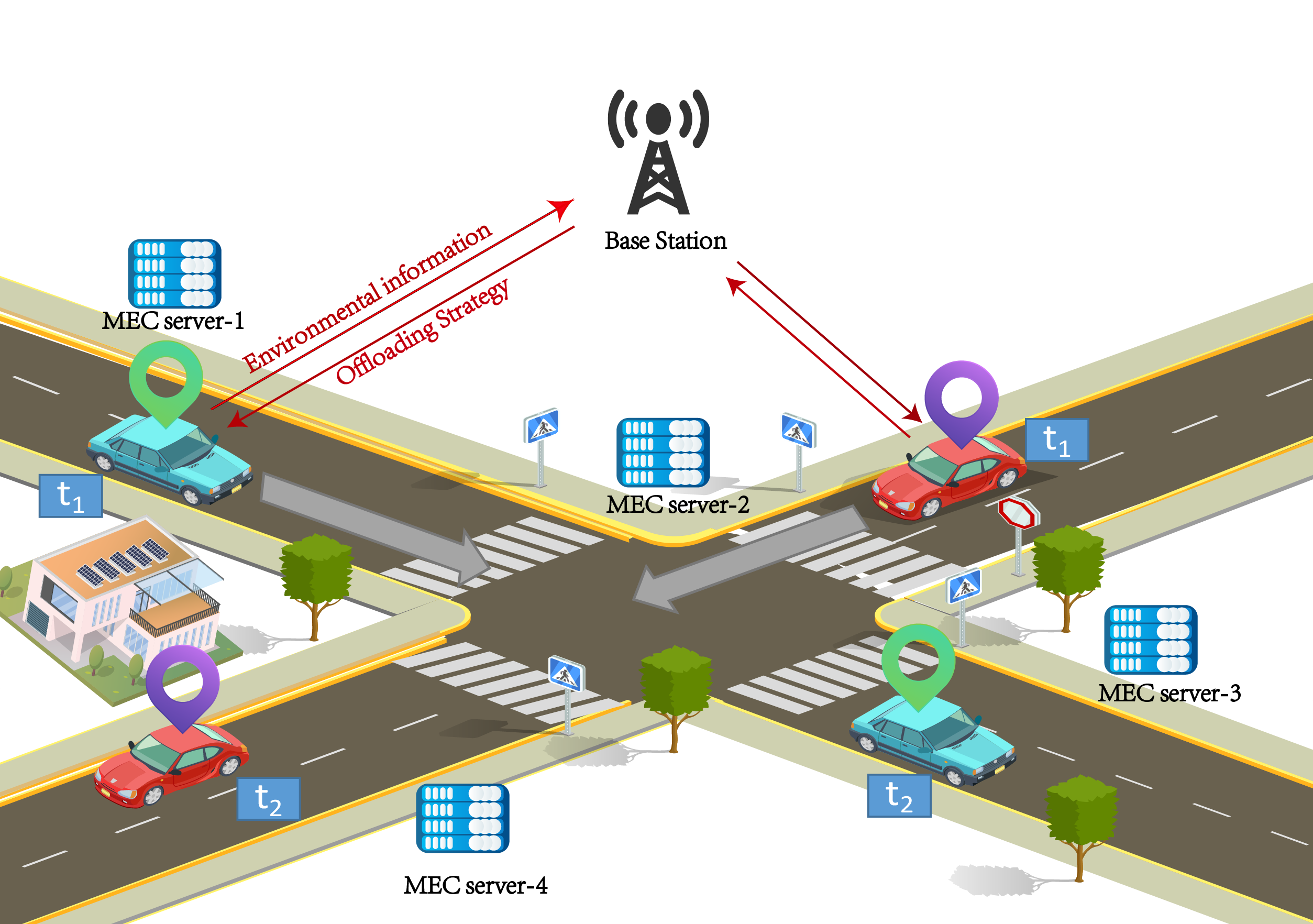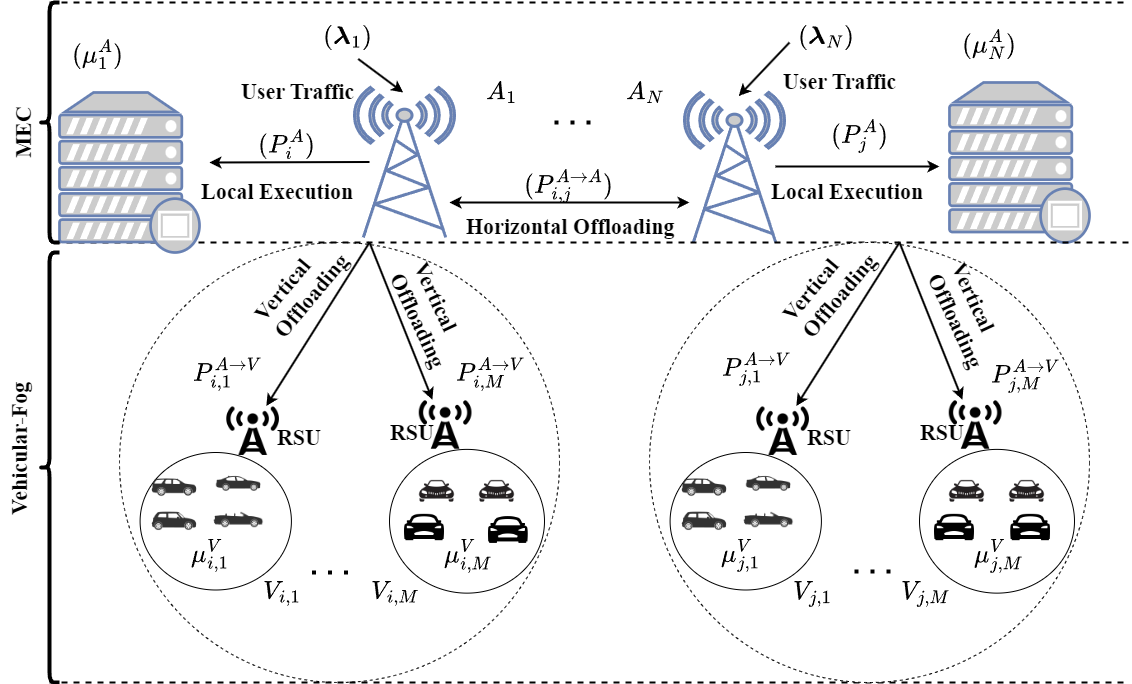Computation Pre-Offloading for MEC-Enabled Vehicular Networks via Trajectory Prediction

0

Sign in to get full access
Overview
- This paper proposes a computation pre-offloading approach for mobile edge computing (MEC)-enabled vehicular networks using trajectory prediction.
- The key ideas are to predict vehicle trajectories using long short-term memory (LSTM) networks and then proactively offload computation tasks to nearby MEC servers.
- This is done to reduce latency and improve resource utilization in vehicular networks.
Plain English Explanation
The paper tackles a problem in internet of vehicles where vehicles need to perform computationally intensive tasks. To address this, the researchers developed a system that predicts where vehicles will travel in the future using machine learning.
With this information, the system can proactively offload some of the vehicles' computational workloads to nearby mobile edge computing servers before the vehicles arrive at those locations. This helps reduce the time it takes for the vehicles to complete their tasks, as well as makes better use of the available computing resources at the edge.
The key innovation is using a type of machine learning model called a long short-term memory (LSTM) network to predict where vehicles will travel. The researchers also developed a double deep Q-network algorithm to make decisions about when and where to offload computations.
Technical Explanation
The paper presents a computation pre-offloading approach for MEC-enabled vehicular networks. The core idea is to predict vehicle trajectories using LSTM networks and then proactively offload computational tasks to nearby MEC servers before the vehicles arrive at those locations.
The system architecture consists of three main components:
- Vehicle Trajectory Prediction: An LSTM network is trained to predict future vehicle locations based on historical mobility data.
- Task Pre-Offloading: A double deep Q-network is used to make decisions about which tasks to offload and when, in order to minimize latency and maximize resource utilization.
- MEC Server Management: MEC servers coordinate with each other to manage computational resources and handle offloaded tasks.
The authors evaluate their approach through simulations and show that it can significantly reduce task completion time and improve resource utilization compared to baseline approaches.
Critical Analysis
The paper presents a well-designed and thorough approach to the problem of computation offloading in MEC-enabled vehicular networks. The use of LSTM networks for trajectory prediction and the double deep Q-network for decision-making are both technically sound and well-executed.
However, the paper does not address several potential limitations and areas for further research:
- The performance of the system may be sensitive to the accuracy of the LSTM trajectory predictions, which could be affected by factors like weather, traffic, or unexpected events.
- The simulation-based evaluation may not fully capture the complexities of real-world vehicular networks, such as variable network conditions or heterogeneous vehicle types.
- The paper does not consider the potential privacy and security implications of predicting vehicle trajectories and offloading sensitive computations to edge servers.
Further research could explore ways to make the system more robust to prediction errors, evaluate it in more realistic scenarios, and address the privacy and security concerns.
Conclusion
This paper presents an innovative approach to computation pre-offloading for MEC-enabled vehicular networks. By leveraging LSTM-based trajectory prediction and a double deep Q-network for decision-making, the system can proactively offload computational tasks to nearby edge servers, reducing latency and improving resource utilization.
The technical approach is sound, and the simulation results are promising. However, the paper also highlights the need for further research to address potential limitations and concerns, such as the sensitivity to prediction accuracy, the complexity of real-world scenarios, and the privacy implications of the proposed system.
Overall, this work represents an important step forward in enabling efficient and low-latency computing in the internet of vehicles, with potential applications in autonomous driving, real-time traffic management, and other vehicle-centric services.
This summary was produced with help from an AI and may contain inaccuracies - check out the links to read the original source documents!
Related Papers


0
Computation Pre-Offloading for MEC-Enabled Vehicular Networks via Trajectory Prediction
Ting Zhang, Bo Yang, Zhiwen Yu, Xuelin Cao, George C. Alexandropoulos, Yan Zhang, Chau Yuen
Task offloading is of paramount importance to efficiently orchestrate vehicular wireless networks, necessitating the availability of information regarding the current network status and computational resources. However, due to the mobility of the vehicles and the limited computational resources for performing task offloading in near-real-time, such schemes may require high latency, thus, become even infeasible. To address this issue, in this paper, we present a Trajectory Prediction-based Pre-offloading Decision (TPPD) algorithm for analyzing the historical trajectories of vehicles to predict their future coordinates, thereby allowing for computational resource allocation in advance. We first utilize the Long Short-Term Memory (LSTM) network model to predict each vehicle's movement trajectory. Then, based on the task requirements and the predicted trajectories, we devise a dynamic resource allocation algorithm using a Double Deep Q-Network (DDQN) that enables the edge server to minimize task processing delay, while ensuring effective utilization of the available computational resources. Our simulation results verify the effectiveness of the proposed approach, showcasing that, as compared with traditional real-time task offloading strategies, the proposed TPPD algorithm significantly reduces task processing delay while improving resource utilization.
Read more9/27/2024


0
Digital Twin Vehicular Edge Computing Network: Task Offloading and Resource Allocation
Yu Xie, Qiong Wu, Pingyi Fan
With the increasing demand for multiple applications on internet of vehicles. It requires vehicles to carry out multiple computing tasks in real time. However, due to the insufficient computing capability of vehicles themselves, offloading tasks to vehicular edge computing (VEC) servers and allocating computing resources to tasks becomes a challenge. In this paper, a multi task digital twin (DT) VEC network is established. By using DT to develop offloading strategies and resource allocation strategies for multiple tasks of each vehicle in a single slot, an optimization problem is constructed. To solve it, we propose a multi-agent reinforcement learning method on the task offloading and resource allocation. Numerous experiments demonstrate that our method is effective compared to other benchmark algorithms.
Read more7/17/2024


0
Koopman based trajectory model and computation offloading for high mobility paradigm in ISAC enabled IoT system
Minh-Tuan Tran
User experience on mobile devices is constrained by limited battery capacity and processing power, but 6G technology advancements are diving rapidly into mobile technical evolution. Mobile edge computing (MEC) offers a solution, offloading computationally intensive tasks to edge cloud servers, reducing battery drain compared to local processing. The upcoming integrated sensing and communication in mobile communication may improve the trajectory prediction and processing delays. This study proposes a greedy resource allocation optimization strategy for multi-user networks to minimize aggregate energy usage. Numerical results show potential improvement at 33% for every 1000 iteration. Addressing prediction model division and velocity accuracy issues is crucial for better results. A plan for further improvement and achieving objectives is outlined for the upcoming work phase.
Read more7/1/2024


0
Multi-Objective Offloading Optimization in MEC and Vehicular-Fog Systems: A Distributed-TD3 Approach
Frezer Guteta Wakgra, Binayak Kar, Seifu Birhanu Tadele, Shan-Hsiang Shen, Asif Uddin Khan
The emergence of 5G networks has enabled the deployment of a two-tier edge and vehicular-fog network. It comprises Multi-access Edge Computing (MEC) and Vehicular-Fogs (VFs), strategically positioned closer to Internet of Things (IoT) devices, reducing propagation latency compared to cloud-based solutions and ensuring satisfactory quality of service (QoS). However, during high-traffic events like concerts or athletic contests, MEC sites may face congestion and become overloaded. Utilizing offloading techniques, we can transfer computationally intensive tasks from resource-constrained devices to those with sufficient capacity, for accelerating tasks and extending device battery life. In this research, we consider offloading within a two-tier MEC and VF architecture, involving offloading from MEC to MEC and from MEC to VF. The primary objective is to minimize the average system cost, considering both latency and energy consumption. To achieve this goal, we formulate a multi-objective optimization problem aimed at minimizing latency and energy while considering given resource constraints. To facilitate decision-making for nearly optimal computational offloading, we design an equivalent reinforcement learning environment that accurately represents the network architecture and the formulated problem. To accomplish this, we propose a Distributed-TD3 (DTD3) approach, which builds on the TD3 algorithm. Extensive simulations, demonstrate that our strategy achieves faster convergence and higher efficiency compared to other benchmark solutions.
Read more4/22/2024